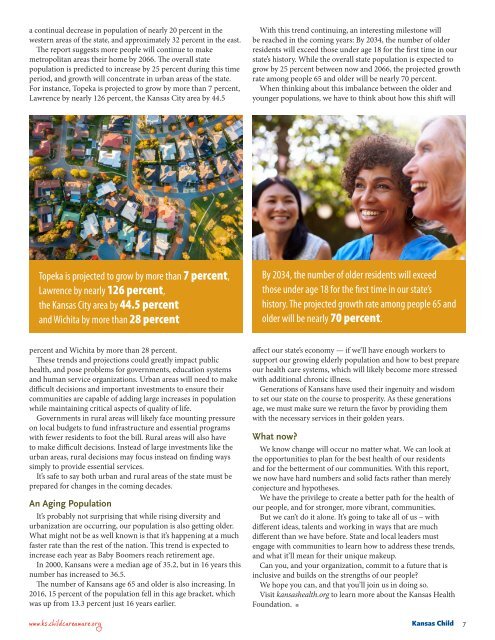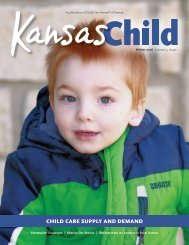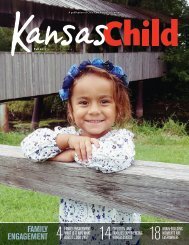2018 Fall Kansas Child
Community vitality, early childhood education
Community vitality, early childhood education
You also want an ePaper? Increase the reach of your titles
YUMPU automatically turns print PDFs into web optimized ePapers that Google loves.
a continual decrease in population of nearly 20 percent in the<br />
western areas of the state, and approximately 32 percent in the east.<br />
The report suggests more people will continue to make<br />
metropolitan areas their home by 2066. The overall state<br />
population is predicted to increase by 25 percent during this time<br />
period, and growth will concentrate in urban areas of the state.<br />
For instance, Topeka is projected to grow by more than 7 percent,<br />
Lawrence by nearly 126 percent, the <strong>Kansas</strong> City area by 44.5<br />
With this trend continuing, an interesting milestone will<br />
be reached in the coming years: By 2034, the number of older<br />
residents will exceed those under age 18 for the first time in our<br />
state’s history. While the overall state population is expected to<br />
grow by 25 percent between now and 2066, the projected growth<br />
rate among people 65 and older will be nearly 70 percent.<br />
When thinking about this imbalance between the older and<br />
younger populations, we have to think about how this shift will<br />
Topeka is projected to grow by more than 7 percent,<br />
Lawrence by nearly 126 percent,<br />
the <strong>Kansas</strong> City area by 44.5 percent<br />
and Wichita by more than 28 percent<br />
By 2034, the number of older residents will exceed<br />
those under age 18 for the first time in our state’s<br />
history. The projected growth rate among people 65 and<br />
older will be nearly 70 percent.<br />
percent and Wichita by more than 28 percent.<br />
These trends and projections could greatly impact public<br />
health, and pose problems for governments, education systems<br />
and human service organizations. Urban areas will need to make<br />
difficult decisions and important investments to ensure their<br />
communities are capable of adding large increases in population<br />
while maintaining critical aspects of quality of life.<br />
Governments in rural areas will likely face mounting pressure<br />
on local budgets to fund infrastructure and essential programs<br />
with fewer residents to foot the bill. Rural areas will also have<br />
to make difficult decisions. Instead of large investments like the<br />
urban areas, rural decisions may focus instead on finding ways<br />
simply to provide essential services.<br />
It’s safe to say both urban and rural areas of the state must be<br />
prepared for changes in the coming decades.<br />
An Aging Population<br />
It’s probably not surprising that while rising diversity and<br />
urbanization are occurring, our population is also getting older.<br />
What might not be as well known is that it’s happening at a much<br />
faster rate than the rest of the nation. This trend is expected to<br />
increase each year as Baby Boomers reach retirement age.<br />
In 2000, Kansans were a median age of 35.2, but in 16 years this<br />
number has increased to 36.5.<br />
The number of Kansans age 65 and older is also increasing. In<br />
2016, 15 percent of the population fell in this age bracket, which<br />
was up from 13.3 percent just 16 years earlier.<br />
affect our state’s economy — if we’ll have enough workers to<br />
support our growing elderly population and how to best prepare<br />
our health care systems, which will likely become more stressed<br />
with additional chronic illness.<br />
Generations of Kansans have used their ingenuity and wisdom<br />
to set our state on the course to prosperity. As these generations<br />
age, we must make sure we return the favor by providing them<br />
with the necessary services in their golden years.<br />
What now?<br />
We know change will occur no matter what. We can look at<br />
the opportunities to plan for the best health of our residents<br />
and for the betterment of our communities. With this report,<br />
we now have hard numbers and solid facts rather than merely<br />
conjecture and hypotheses.<br />
We have the privilege to create a better path for the health of<br />
our people, and for stronger, more vibrant, communities.<br />
But we can’t do it alone. It’s going to take all of us – with<br />
different ideas, talents and working in ways that are much<br />
different than we have before. State and local leaders must<br />
engage with communities to learn how to address these trends,<br />
and what it’ll mean for their unique makeup.<br />
Can you, and your organization, commit to a future that is<br />
inclusive and builds on the strengths of our people?<br />
We hope you can, and that you’ll join us in doing so.<br />
Visit kansashealth.org to learn more about the <strong>Kansas</strong> Health<br />
Foundation. n<br />
www.ks.childcareaware.org <strong>Kansas</strong> <strong>Child</strong> 7

















